 A shekere (or sekere) is a beautiful and unique instrument originating in West Africa that appears in various shapes, sizes and forms throughout the continent of Africa. Made from a simple dried gourd with a beaded “skirt”, shekeres are a great addition to any environment where children are learning about music or world cultures.
A shekere (or sekere) is a beautiful and unique instrument originating in West Africa that appears in various shapes, sizes and forms throughout the continent of Africa. Made from a simple dried gourd with a beaded “skirt”, shekeres are a great addition to any environment where children are learning about music or world cultures.
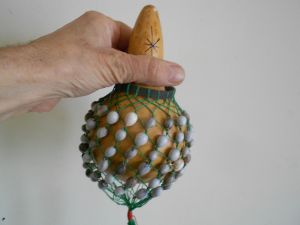 If you’re finding it hard to locate or purchase a shekere for your classroom, home or homeschool, you might consider making your own. Other then the dried gourd, the additional materials are easy to find and the beading process is “easy to moderate” for beginning crafters. In fact, since the stringing and beading is the part of the process that generates the most questions and confusion, we’ve partnered with Carrie P. from a wonderful blog called Crafty Moms Share to develop a step-by-step tutorial for making your own dried gourd shekere. (Complete gourd tutorial and other related shekere posts can be found at the links below).
If you’re finding it hard to locate or purchase a shekere for your classroom, home or homeschool, you might consider making your own. Other then the dried gourd, the additional materials are easy to find and the beading process is “easy to moderate” for beginning crafters. In fact, since the stringing and beading is the part of the process that generates the most questions and confusion, we’ve partnered with Carrie P. from a wonderful blog called Crafty Moms Share to develop a step-by-step tutorial for making your own dried gourd shekere. (Complete gourd tutorial and other related shekere posts can be found at the links below).
 Beads, Seeds, Nuts or Seashells
Beads, Seeds, Nuts or Seashells
Along with beads, almost any small, roundish, rattling object can be used as the noise-makers on a shekere. If you take a close look at the shekeres pictured above, you’ll notice beads as well as seeds woven into the netting. In Africa, some shekeres also use seashells or hard seeds or nuts with holes drilled though them as part of their unique design.
Add Some String
The skirt of a shekere is created from a type of string or twine that is durable and will not break or stretch. Since cotton twine will stretch, nylon or hemp is a better choice for creating a working shekere. Because the top circle or collar of the netting holds all the other strings in place, some craftspeople pick a thicker string for this or braid the twine for a more durable start to the project.
 And Some Knots!
And Some Knots!
With your collar in place around the gourds neck, you are ready to add the strings.
Cut a number of strings (enough to fit around the gourd) approximately 30 inches long. Fold each string in half and make a slip knot with it around the collar. To make a slip knot, put the folded string under the collar with the fold on top and then bring the ends through the loop of the fold and collar and tighten.
Once you have all the strings you desire in place you will tie a loop knot to secure each location. A loop knot is where you make a “6” with your strings and bring the end through the loop of it. This is the type of knot we will be using for the rest of the project.
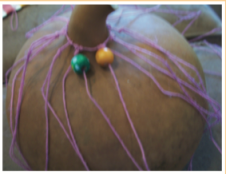 Add The Beads
Add The Beads
Here are Carrie’s great suggestions for getting the hang of adding beads to the skirt:
Adding the beads is where you creativity really comes into play.
You can do many different things with the beads. Some put a bead on each string, others put two strings through a bead. Some put a single bead between knots and others go up to three beads before knotting. The important thing is to work with a string from two different knots.
Once you have your bead(s) in place, tie a loose loop knot. I re-started many of mine because I did not like how the first round looked and found they lay better with looser knots. Do an entire round before starting the next.
Once you have one round complete, start the next. Stay consistent with however you’ve started with beads and knots, but again you want to use strings from different knots. This will bring the beads in the first round closer together. Continue doing a round at a time until you have the skirt you want.
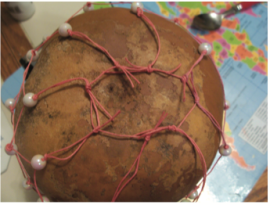 Finish The Instrument!
Finish The Instrument!
Here are Carrie’s two descriptions for two methods of finishing the skirt and completing the shekere:
Method 1: The first is to have another loop similar to the collar (braided if you used braided) and the same size. Then you tie your ends to the loop so it hangs loosely below the gourd.
Method 2: If your gourd is small you can take an 8-inch string and tie the ends together. This is easier to do with another person holding your shekere for you to tie them together.
 Making Music!
Making Music!
If you take a look at the resources below you’ll find many wonderful ways to check out the sound of traditional shekeres or explore music with the ones you’ve created.
Enjoy!
Complete Tutorials
http://www.teacherspayteachers.com/Product/Make-Your-Own-Shekere-African-Percussion-Instrument-Tutorial-992550
http://dariasvillagestore.storenvy.com/collections/34585-all-products/products/4084121-make-your-own-shekere-african-instrument-tutorial
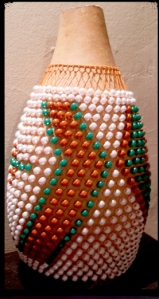 Links and Resources
Links and Resources
Hear A Shekere
http://www.dariamusic.com/shekere.php
Color a Shekere Online
http://www.dariamusic.com/color_Shekere.php
Carries Crafty Moms Share Blog
craftymomsshare.blogspot.com/
Sekere.com – Beaded Sekeres from Master Craftswoman, Sara Fabunmi
http://www.sekere.com
Cultural Value of the Shekere, Article By Sara Fabunmi
THE CULTURAL VALUE OF THE SEKERE
Make a Classroom Shekere (From A Gourd)
http://tinytappingtoes.wordpress.com/2013/08/05/easy-gourd-shekere-for-a-child-or-a-classroom/
Make a Recycled Shekere (From A Milk Jug)
http://www.dariamusic.com/make_Shekere.php
An Alphabet Shekere Game
http://www.trueaimeducation.com/2012/10/guest-post-learning-letters-with-an-alphabet-shekere.html
 Although we don’t generally cover news about crowd-sourced projects, this one is so different and so special, we wanted to share it here and encourage you to participate.
Although we don’t generally cover news about crowd-sourced projects, this one is so different and so special, we wanted to share it here and encourage you to participate.
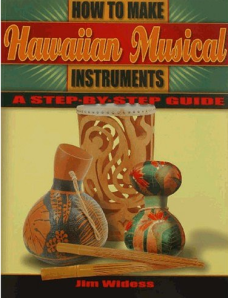
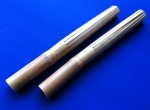
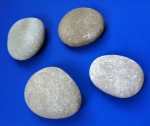






















 All over the world people are celebrating this joyous season in so many different ways. There are beautiful religious ceremonies, family and community activities, decorations, presents, great food. And then, there’s music. As a musician and a global traveler, I wanted to share some favorite melodies and music that create holiday magic in various cultures throughout the world.
All over the world people are celebrating this joyous season in so many different ways. There are beautiful religious ceremonies, family and community activities, decorations, presents, great food. And then, there’s music. As a musician and a global traveler, I wanted to share some favorite melodies and music that create holiday magic in various cultures throughout the world. Have you ever seen a Native American rattle made from the shell of a turtle? It’s used by a variety of tribes and it’s quiet sound is perfect for accompanying singing or special ceremonies.
Have you ever seen a Native American rattle made from the shell of a turtle? It’s used by a variety of tribes and it’s quiet sound is perfect for accompanying singing or special ceremonies. My carving is an effort to further the family tradition and explore the connection between cultures, myth and music.
I started out making Native inspired drum sticks also referred to as beaters which led to learning how to make Turtle Rattles. I began making the beaters after being gifted from my girlfriend a hand drum and beater making kit from Noc Bay Trading Company. They included a small black and white instruction on how to create a beater from a wooden dowel, piece of deer hide, artificial sinew, yarn and glue.
My carving is an effort to further the family tradition and explore the connection between cultures, myth and music.
I started out making Native inspired drum sticks also referred to as beaters which led to learning how to make Turtle Rattles. I began making the beaters after being gifted from my girlfriend a hand drum and beater making kit from Noc Bay Trading Company. They included a small black and white instruction on how to create a beater from a wooden dowel, piece of deer hide, artificial sinew, yarn and glue. When making the turtle rattles I use a power hand drill to drill out the holes and attach the leather using a thick needle and artificial sinew. I fill the turtle rattle with sea shells that creates the percussion. I handburn the rattles with a Nisburner hand burner. Hand burning; called pyrography, is one of my favorite parts of creating art. Burning yourself can be a bit painful but kind of comes with the territory.
When making the turtle rattles I use a power hand drill to drill out the holes and attach the leather using a thick needle and artificial sinew. I fill the turtle rattle with sea shells that creates the percussion. I handburn the rattles with a Nisburner hand burner. Hand burning; called pyrography, is one of my favorite parts of creating art. Burning yourself can be a bit painful but kind of comes with the territory.
 You can find a kid’s craft version of a turtle rattle made from recycled take-out containers here:
You can find a kid’s craft version of a turtle rattle made from recycled take-out containers here: